This isn’t your typical snooze-fest lecture; it’s a practical step-by-step map to turning any clinic from meh to memorable.
Ever been in a clinic setting where you felt like a lost satellite? Yeah, been there. Today, we’re aiming to change that. But first, picture this:
a world where patients aren’t just in the passenger seat of their health journey; they’re behind the wheel, steering the ship alongside their providers.
That’s the magic of patient engagement in healthcare—it’s the spark that ignites better outcomes and tighter bonds between patients and providers.
Now, hold onto your hats, ‘cause here’s where it gets spicy.
Enter the Patient Engagement Gauge™ Tool and the Patient Engagement Printable Planners™.
These ain’t your run-of-the-mill tools; oh no, these are secret weapons in the battle for better healthcare clinics and overall business outcomes.
So, sit back, grab your favorite beverage and let’s start.
The Not-So-Boring Blueprint for Engagement Metrics
Alright, before we dive into our first tool, let’s talk about key patient engagement metrics that it measures.
We’ve got four major players on the field – satisfaction, appointment attendance, medication adherence, and self-management skills.
First off, satisfaction is like the pulse of patient engagement. Happy patients usually mean things are running smoothly. It’s about checking in on how content they feel about the care they’re getting.
Then, there’s appointment attendance. It’s pretty simple—when patients show up, the healthcare team can do their thing and keep the ball rolling.
Medication adherence is another piece of the puzzle. Think of it like following a recipe; it’s important for effective treatment and better health outcomes.
Lastly, self-management skills. This is how patients handle their own health, from lifestyle choices to stress management.
Why are these metrics a big deal?
Well, they’re like markers that show how well patients are involved in their healthcare journey.
And here’s the kicker—when these metrics shine, healthcare outcomes tend to improve.
It’s like the perfect sync between patients and their healthcare squad, leading to overall better health.
Now, while these metrics are pretty solid, there’s room for customization.
You can add your own metrics if there’s something specific you want to track.
But these four amigos – satisfaction, appointment attendance, meds adherence, and self-management – they’re the heavy hitters.
They give you a solid view of how patients are doing in their healthcare journey.
Patient Engagement Gauge tool: Your Clinic’s Crystal Ball
The Patient Engagement Gauge is a bit like a fancy calculator.
It does most of the heavy lifting for you. And it aims to measure the patient engagement score.
Here’s how it rolls:
First, find your metrics. Think patient satisfaction, showing up for appointments, sticking to meds, and self-management.
Then, it’s time for the weights. Give each of these metrics a number based on how crucial they are in your patient engagement game plan. The bigger the number, the more weight it carries.
Now comes the scores. Rate each metric on a scale from 0 to 100. So, satisfaction might get an 80, attendance a 90, meds a 75, and self-management a 60.
Punch these numbers into the tool. It’s like a math whiz— it automatically crunches each metric’s score with its weight to give you a Weighted Score.
And now, the big reveal—the Overall Score. The tool will add up all those Weighted Scores and divide it by the total of your weights.
That’s your Overall Patient Engagement Score. You can try here:

| Metric | Weight | Score | Weighted Score |
|---|---|---|---|
| Patient Satisfaction ✖ | |||
| Appointment Attendance ✖ | |||
| Medication Adherence ✖ | |||
| Self-Management Skills ✖ | |||
| Overall Score: | |||
Don’t forget, this tool’s got flexibility. You can tweak weights or swap metrics to match how your engagement strategy evolves.
Engagement Printable Planners: Keeping Patients Engaged Without Popcorn
 Now let’s talk shop about the Patient Engagement Printable Planners. They’re not your typical spreadsheets or the soul-sucking paperworks.
Now let’s talk shop about the Patient Engagement Printable Planners. They’re not your typical spreadsheets or the soul-sucking paperworks.
No siree, these planners are the tools that kick patient engagement into gear. It’s all about action, strategy, and fine-tuning that patient-provider dance to perfection.
They will help you from setting goals up until tracking progress, step-by-step.
You can download all the printable planners PDF version here .
Let’s start with the first section of the planners.
1) General Assessment
The general assessment section is a checklist for any clinic or medical business performance.
It digs into a few crucial areas:
Appointment Scheduling Ease: It asks about how breezy or tricky it is for patients to book appointments. The scale ranges from ‘a walk in the park’ to ‘a bit of a hassle.’
Wait Times: It dives into how long patients typically wait before they see a healthcare provider. This helps gauge if patients spend more time in the waiting room than necessary.
Remote Appointment Options: It checks the tools available for patients who can’t visit the office physically. Options like telehealth, phone, or email consultations are on the radar.
Disability Accommodation: This one measures how well the healthcare provider caters to patients with disabilities. It ranges from minimal to significant accommodations.
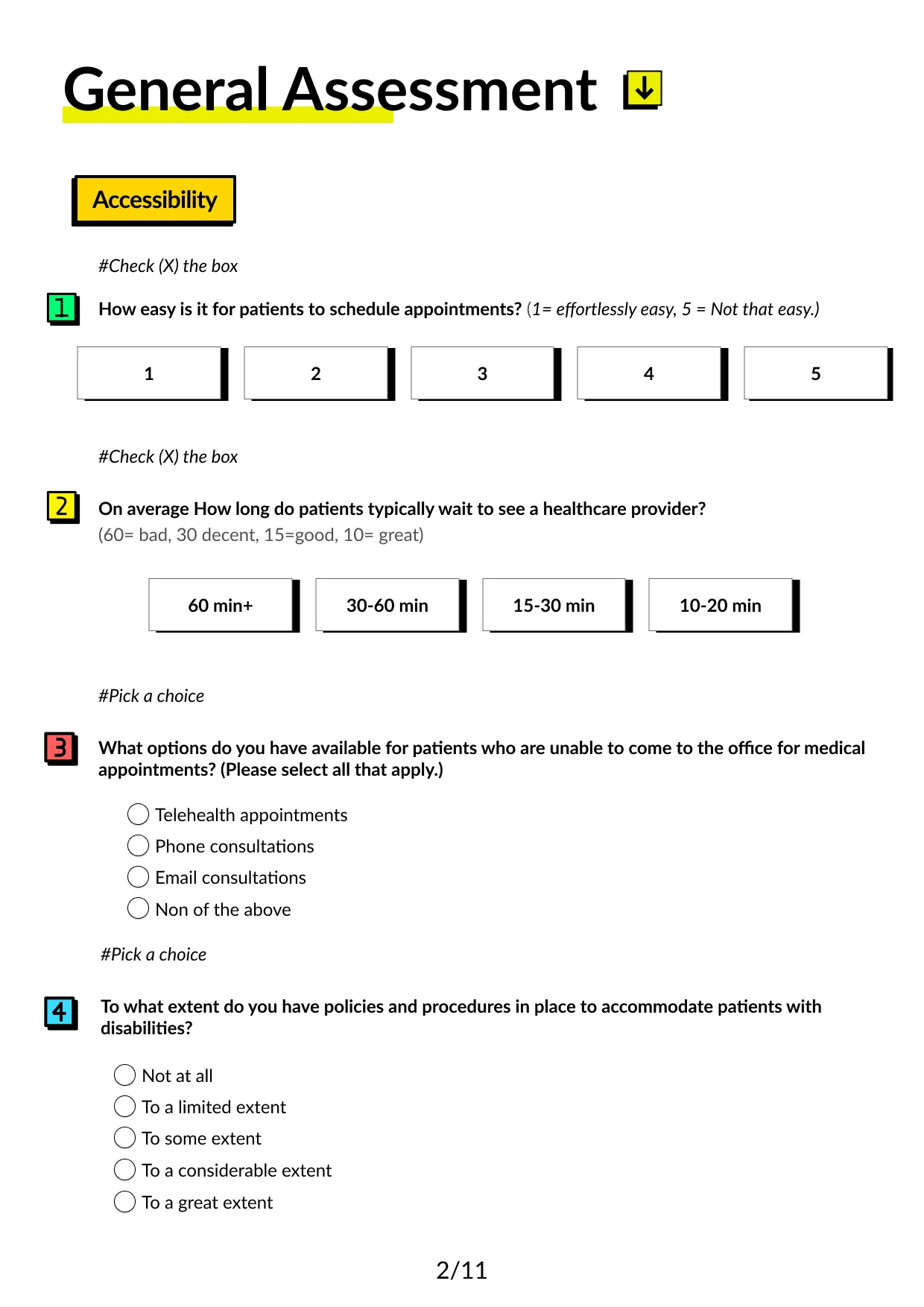 This next page dives into how a clinic connect and inform their patients:
This next page dives into how a clinic connect and inform their patients:
How Patients Are Informed: This one’s about how the clinic educates patients on their condition and treatment.
Communication Preferences: It explores the methods for patients to ask questions between appointments.
Post-Appointment Follow-Up: Here, it’s about how often the clinic checks in with patients after appointments.
Patient Involvement: This one’s a free space to talk about how they involve patients in decision-making.
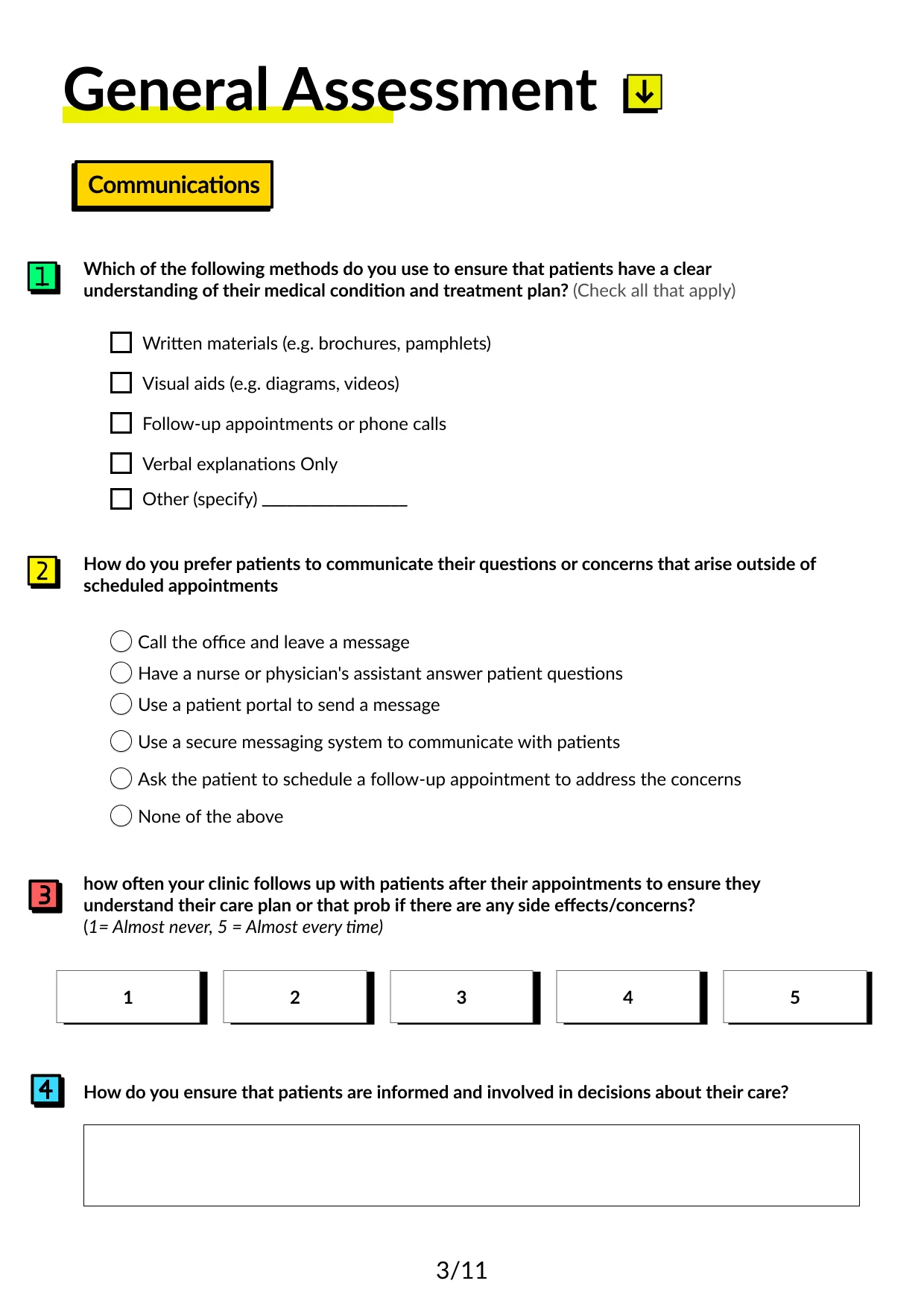
The next move on this journey involves gathering data straight from the source – the patients themselves.
We’ve set up a toolkit of surveys and methods in our resources section, making it easier than a Sunday stroll.
These tools help collect valuable insights, sort of like gathering puzzle pieces that make up the big picture of patient engagement.
Once armed with this data, we bring in the heavy artillery – the Patient Engagement Gauge. This nifty tool acts as our compass, showing where we stand right now.
Think of it as the ‘before’ snapshot, setting the stage for a comparison later down the road. It’s all about tracking progress and shaping the path ahead.
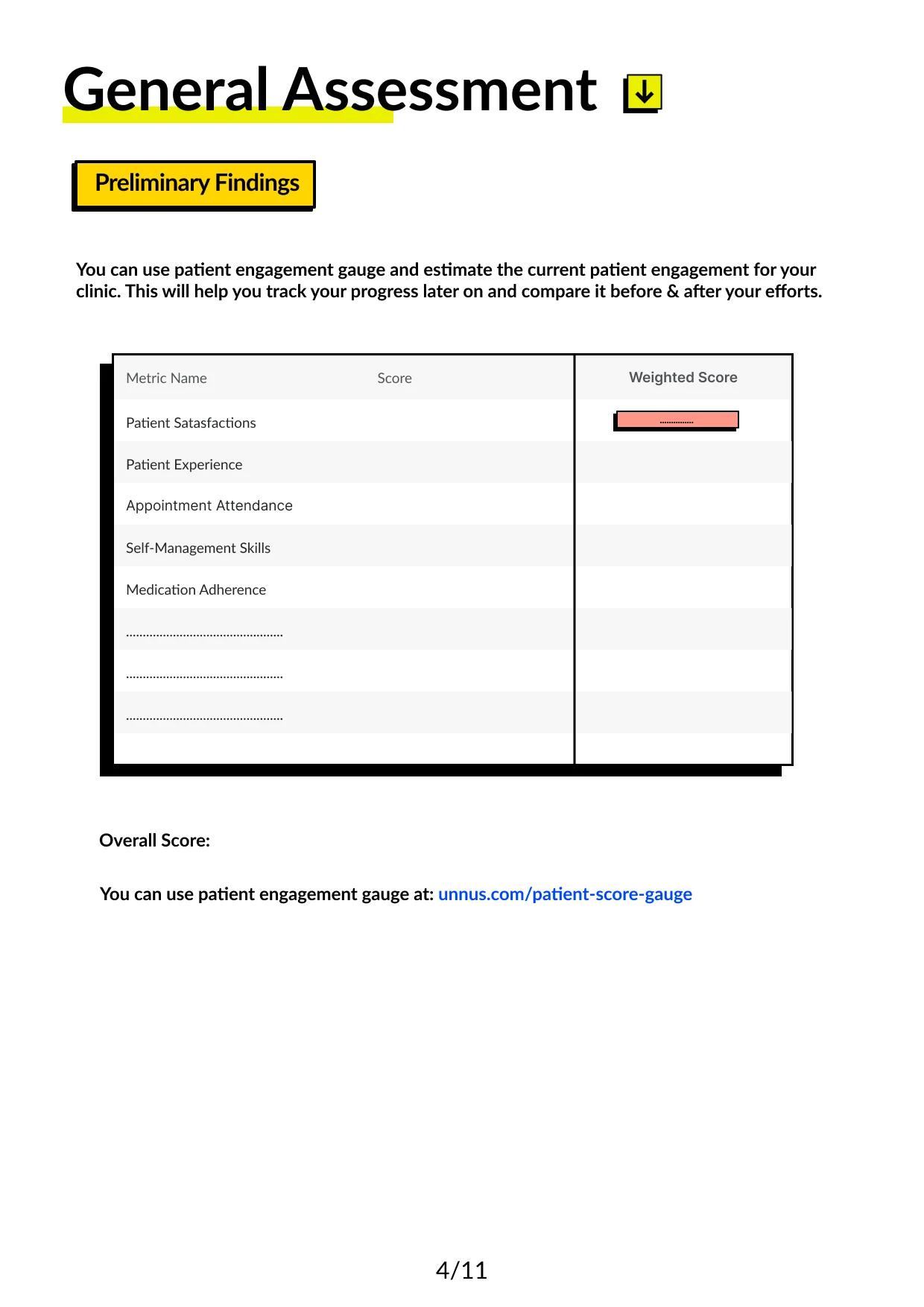
2) Action Plan
In the action plan pages, we’re putting pen to paper and getting down to business.
First off, we’ve got the first page of the action plan where we define our objectives.
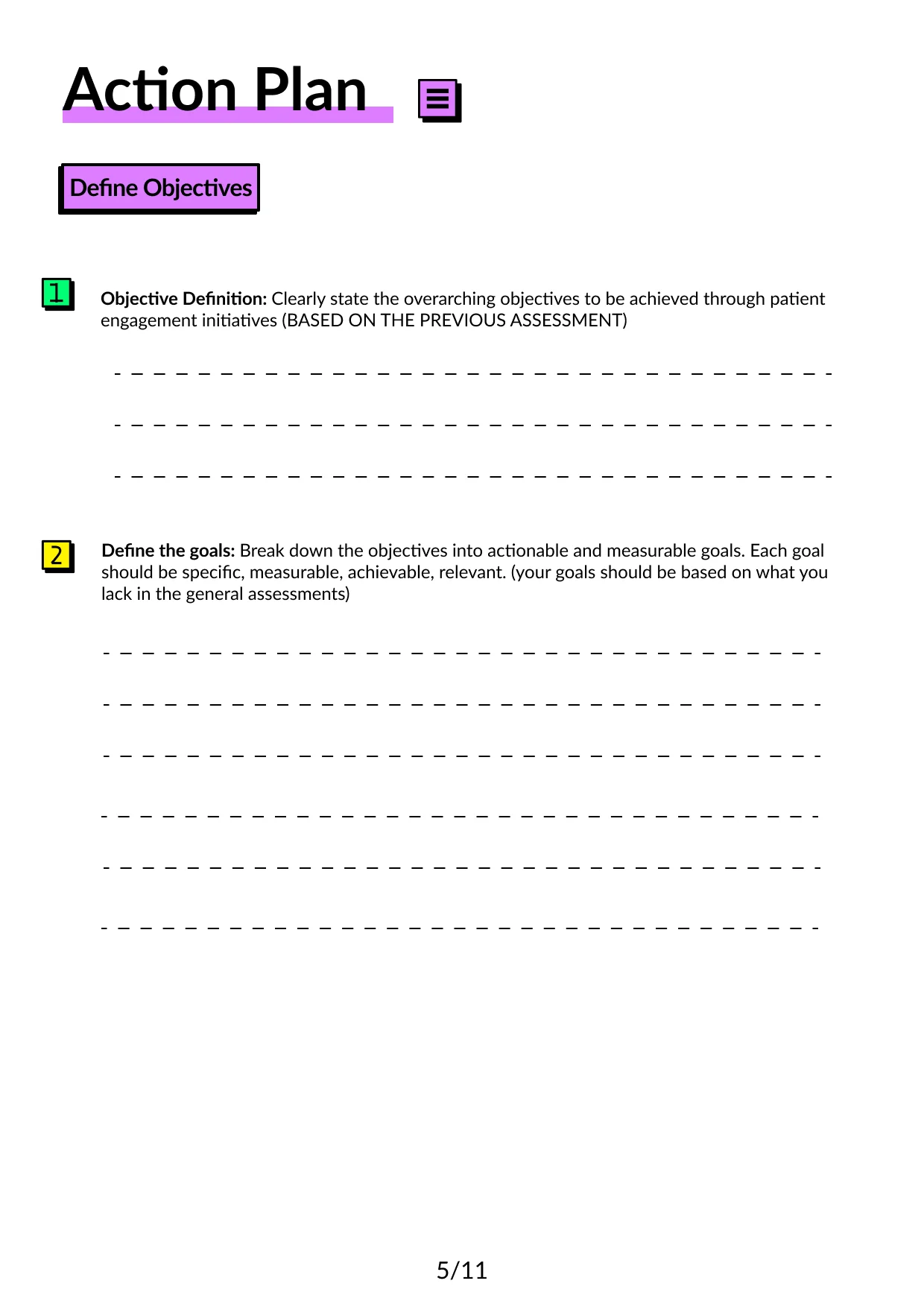
This isn’t just jotting down wishful thinking; it’s about setting clear goals based on the insights we gained from the general assessments.
We’re talking about big-picture here, overarching objectives that’ll steer our patient engagement initiatives in the right direction.
Then, we dive deeper. We break down these objectives into bite-sized, doable goals. These goals? They’re specific, measurable, achievable, relevant – the whole shebang.
And guess what? They’re based on the areas we need to amp up from our earlier assessments.
Now, moving to the next page. We’ve got an Action Priority Matrix, and in this chart, we’re plotting our action strategies.
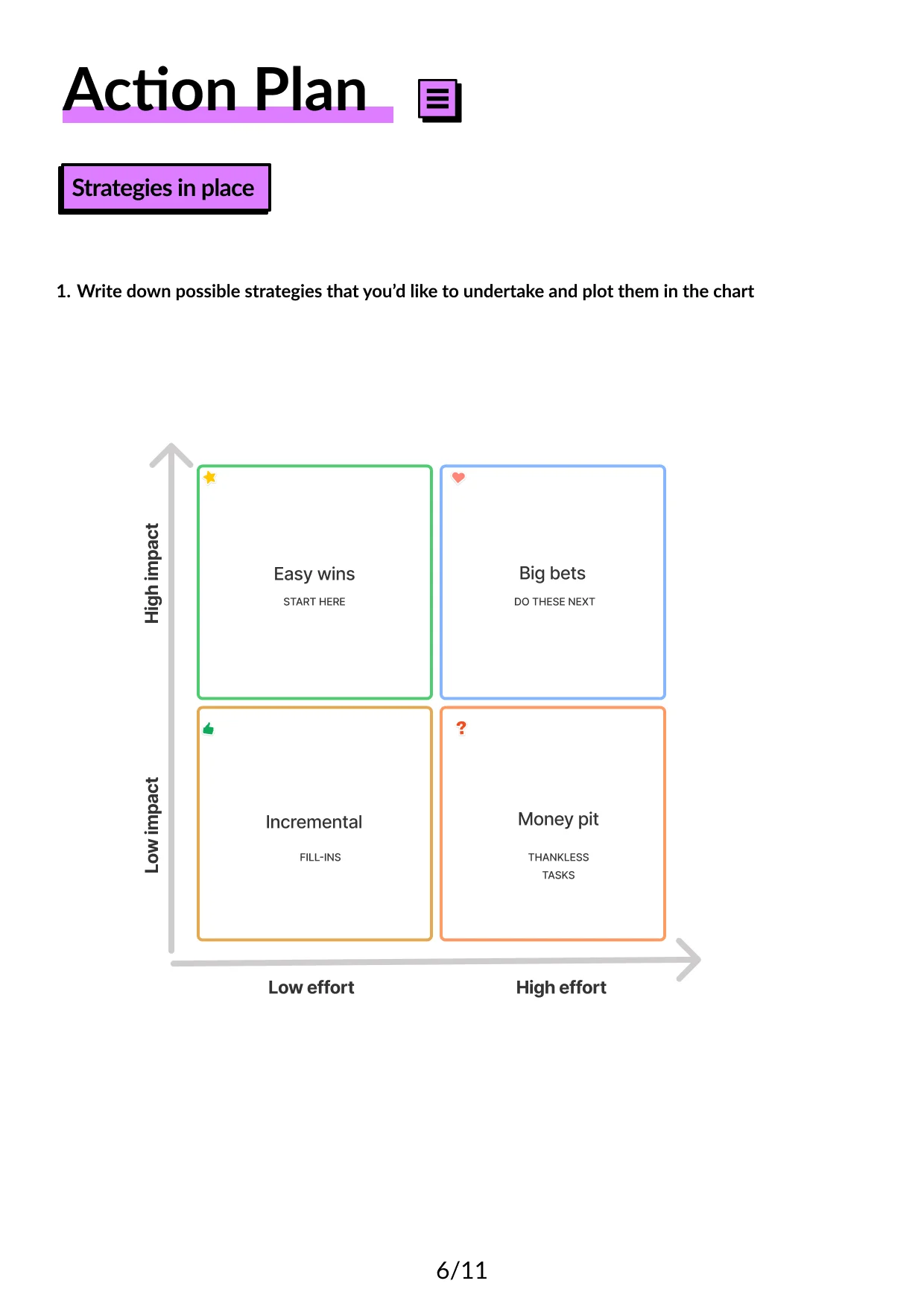
This tool is weighing each strategy based on its impact and effort. We’re aiming to pick the high-impact, low-effort strategies first, setting our priorities straight.
An example of strategies to use are:
No-wait time appointment solutions: make it easy to book you, no-wait times, just book a ticket in a queue, when your number comes, you enter. Check this patient queue solution for how to implement it.
Diverse Communication Mix: It’s all about variety—open up telemedicine, chat, and online portals to keep everyone in the loop.
Patient Workshops & Info Galore: Spice things up with workshops and useful info packs to keep patients in the know-how about their health.
Personalized Care Plans: Think of it like a tailored suit—personalized care plans bring that VIP touch to every patient.
Feedback: The Good Stuff: Get the feedback rolling; it’s like the Yelp for healthcare—patients sharing, clinics caring. Use any sort of tools or app that facilitate this process.
Community Love: Create a vibe where patients feel part of a community—events, forums, support groups; a virtual hug beyond check-ups.
Health knowledge Drills: Get everyone on the same page—offer programs to make sure patients understand their health case.
Follow-up Game Strong: Keep those check-ins regular—follow-ups to ensure the patient-provider relationship isn’t a one-time gig.
Knowledge is Power: Spread the good word—educate patients on health stuff through campaigns that stick.
This list is by no means definitive, you can add more strategies as you see fit.
3) Progress Tracking
Moving on to the Progress Tracking section – this part is about keeping tabs on our strategies.
We’ve got these strategies all lined up, and now it’s time to break them down into bite-sized tasks.
So, we’re dissecting these strategies into smaller to-do lists, creating a roadmap to achieve them. It’s about breaking down the big picture into actionable steps.
Now, jot down each task related to each overarching strategy and check ‘em off once they’re done.
It’s like a task tracker, a simple way to see how each step is progressing.
You can print out as many copies of this page as needed – one for each strategy you’re working on.
![]()
4) Engagement Monitoring
This is the Moment of Truth section. It’s time to shine a flashlight on our efforts after working at least for six months with those action plans.
We’re asking, “Hey, did all that hard work pay off?”.
But to really get the lowdown on how our efforts are panning out, we gotta hear it straight from the patients.
Yep, that means conducting once again patient surveys.
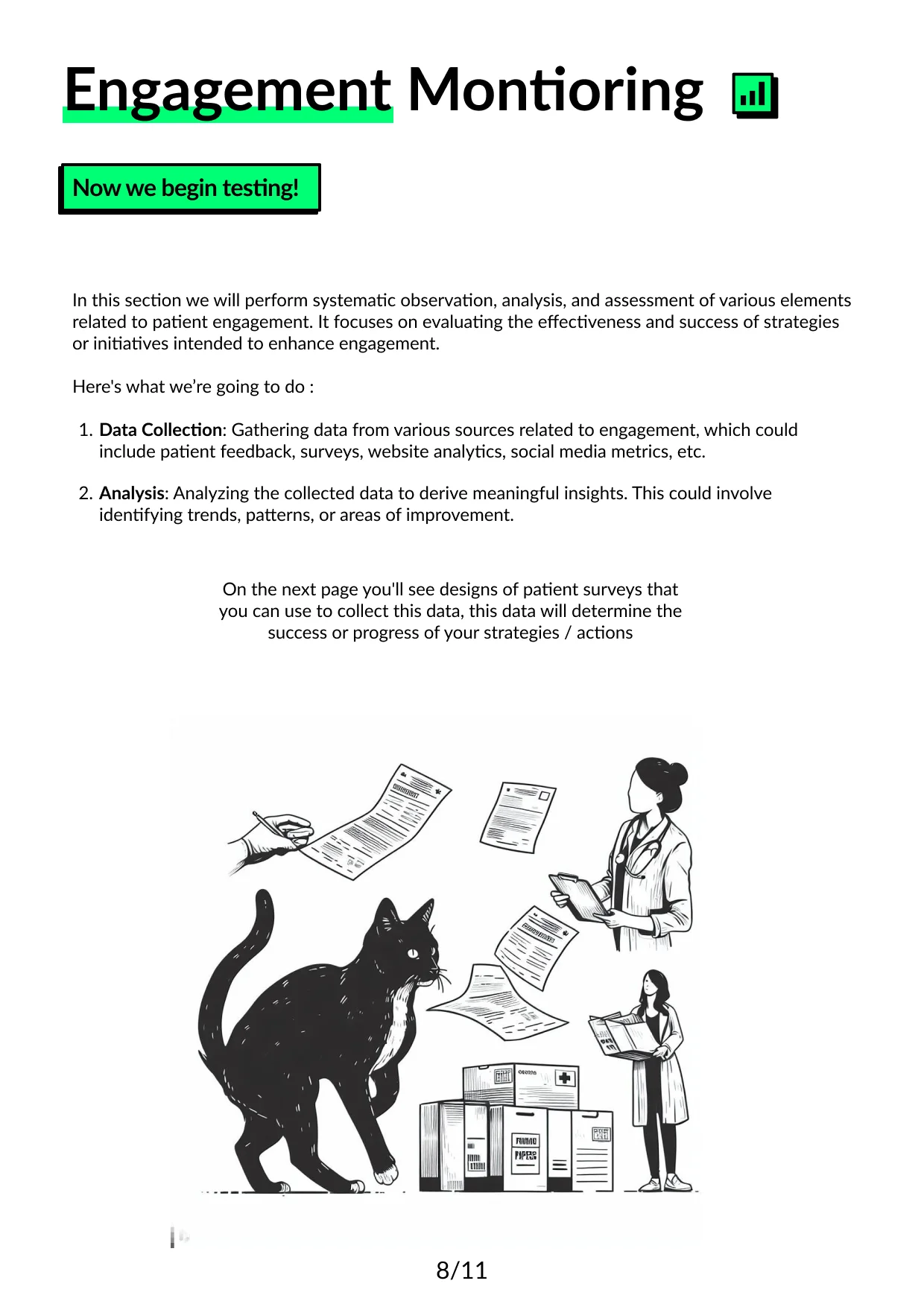
Because we’re doing it once every 6 months, this won’t be much of a hustle for the patients.
Now, these surveys are like our golden ticket to understanding what’s clicking and what needs a little tune-up in our patient engagement strategies.
We’ll ask patients about their experiences, what’s working for them, and where we might need to step up our game.
I included a sample survey below that you can use or modify as you wish.
Again always refer back to the resources pages for more tools to conduct them.
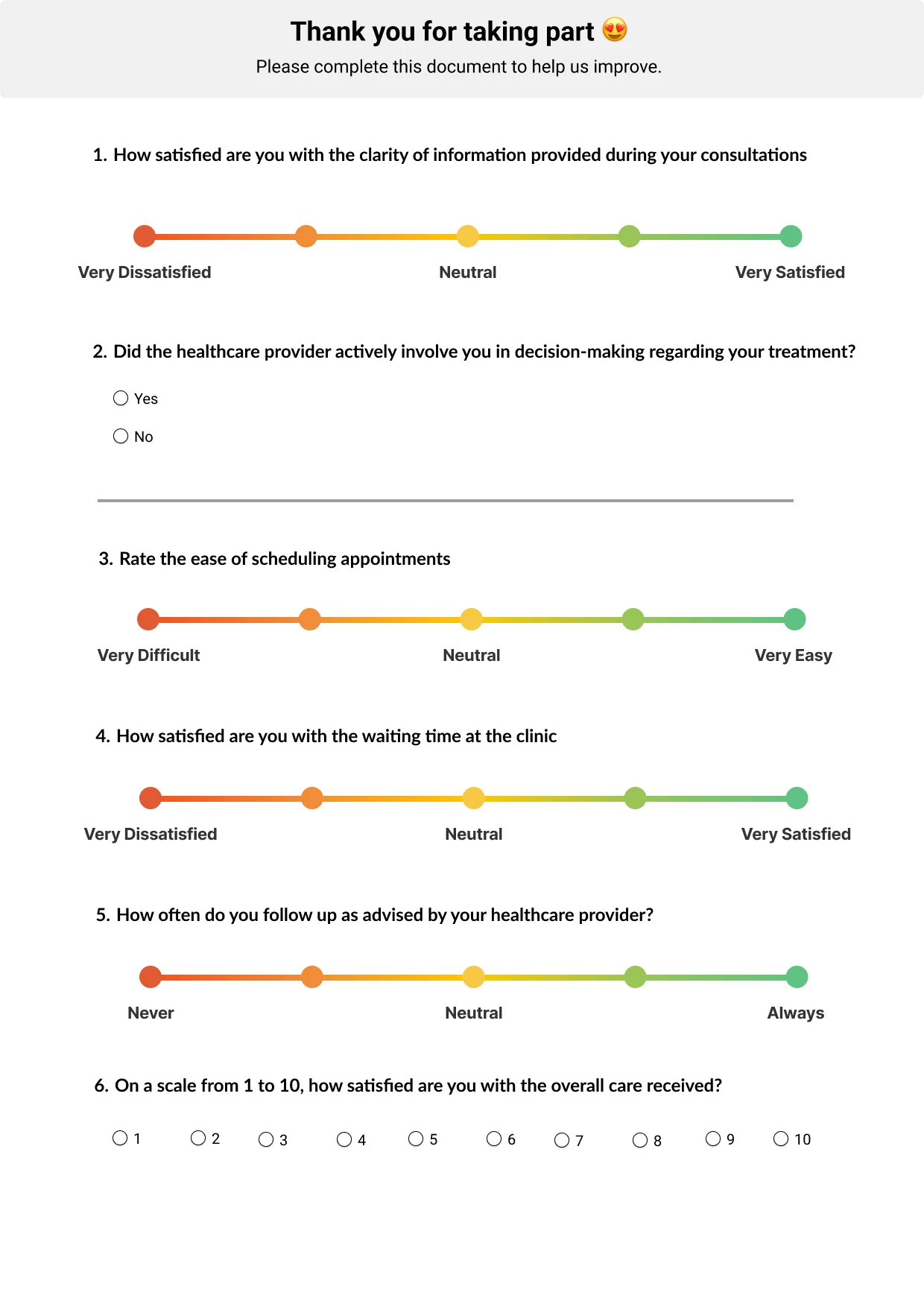
After you collect the current data, we’ll start checking on the metrics we saw before if they’re looking shinier, if patients are happier, if they’re showing up more, sticking to their meds, and rocking their self-management skills.
It’s like looking at before and after pictures to see if we’ve sculpted a six-pack of success.
There’s only two results here, either: “Hey, we did it!” or “We’ve still got some work to do.”
5) Plan Evaluation
Here is where we take a good, hard look at what we set out to do versus what actually went down.
This part’s all about accountability—checking the boxes we scribbled earlier on and seeing if they delivered the goods.
We’re getting real and rating our efforts, highlighting what hit the bullseye and what might’ve missed the mark and how we can adjust.
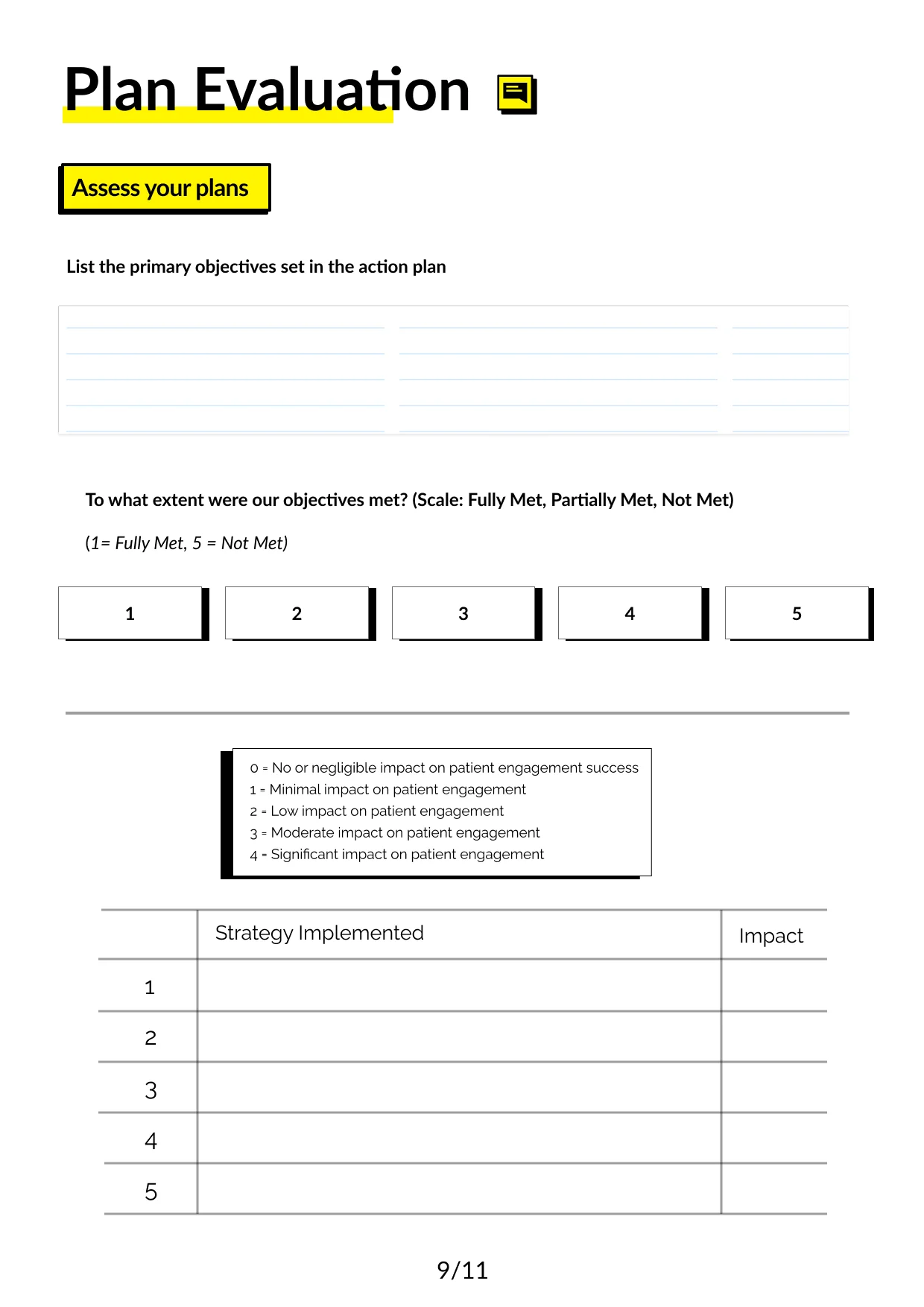
1) Listing Objectives:
Write down those main goals you penned earlier on. This is the moment to see if they held up their end of the bargain.
2) Objective Check:
Rate how those goals fared, whether they totally hit the mark or missed a step. Use a 1 to 5 scale—think “Fully Met” to “Not Met.”
3) Strategy Game:
Get that table going. List your strategies. Then, give each one a score based on its impact:
0 - Nothing much, didn’t move the engagement needle.
1 - Just a bit, a small flicker in patient engagement.
2- Low impact, but hey, it’s there.
3- Moderate sway, get the patients looking.
4- Boom! Big impact on engaging those patients.
Give a close-up of what rocked it and what needs a little doctoring for a better encore next time.
Next page we have first the Patient Feedback: Here, you sum up what the patients had to say during or after our action plan took off.
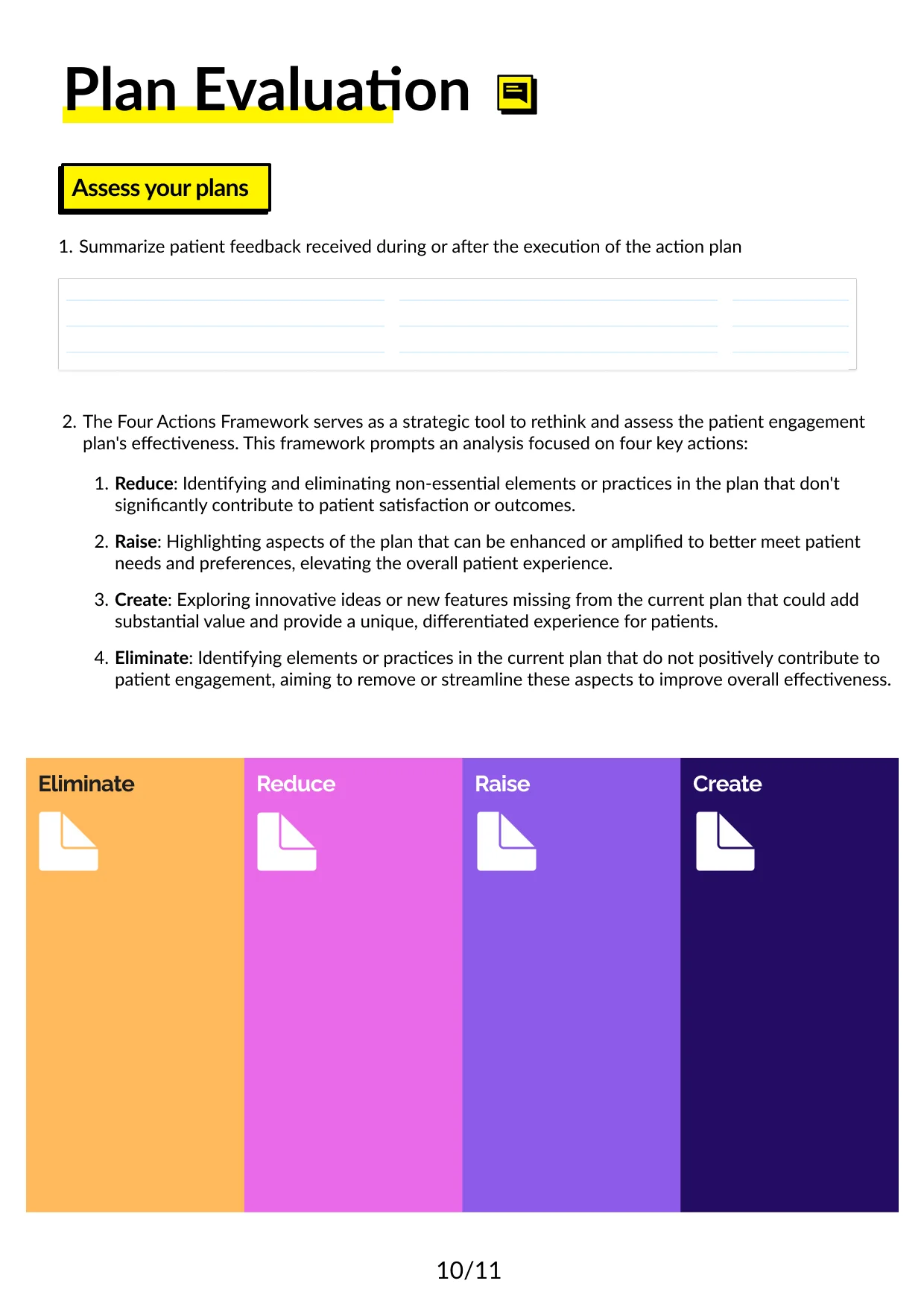
It’s like grabbing the highlights of their thoughts, concerns, or praises in one spot.
Second, we have Four Actions Framework: Think of this as our four-column brainstorming pad.
1) Reduce: is all about decluttering— write down anything that’s not pulling its weight in the plan.
2) Raise: is where the magic happens, where we shine a spotlight on what’s already working and think, “How do we make this even better?” jot that down.
3) Create: is the fun brainstorm zone—what cool, fresh ideas can we bring in to level up the patient experience?
4) Eliminate: is where we play judge and jury, booting out anything that’s not serving the patient engagement game. It’s like a tactical toolkit for smart revamps and strategic upgrades.
Note that Reduce is about minimizing non-crucial elements, while eliminating is the complete removal of aspects hindering patient engagement.
6) Resources page
Within this resources section lies a goldmine of tools and articles, carefully assembled to bolster your patient engagement endeavors.
It’s a hub loaded with actionable plans, engagement tools, branding insights, and expert courses—a treasure trove to finesse and enhance your plans.
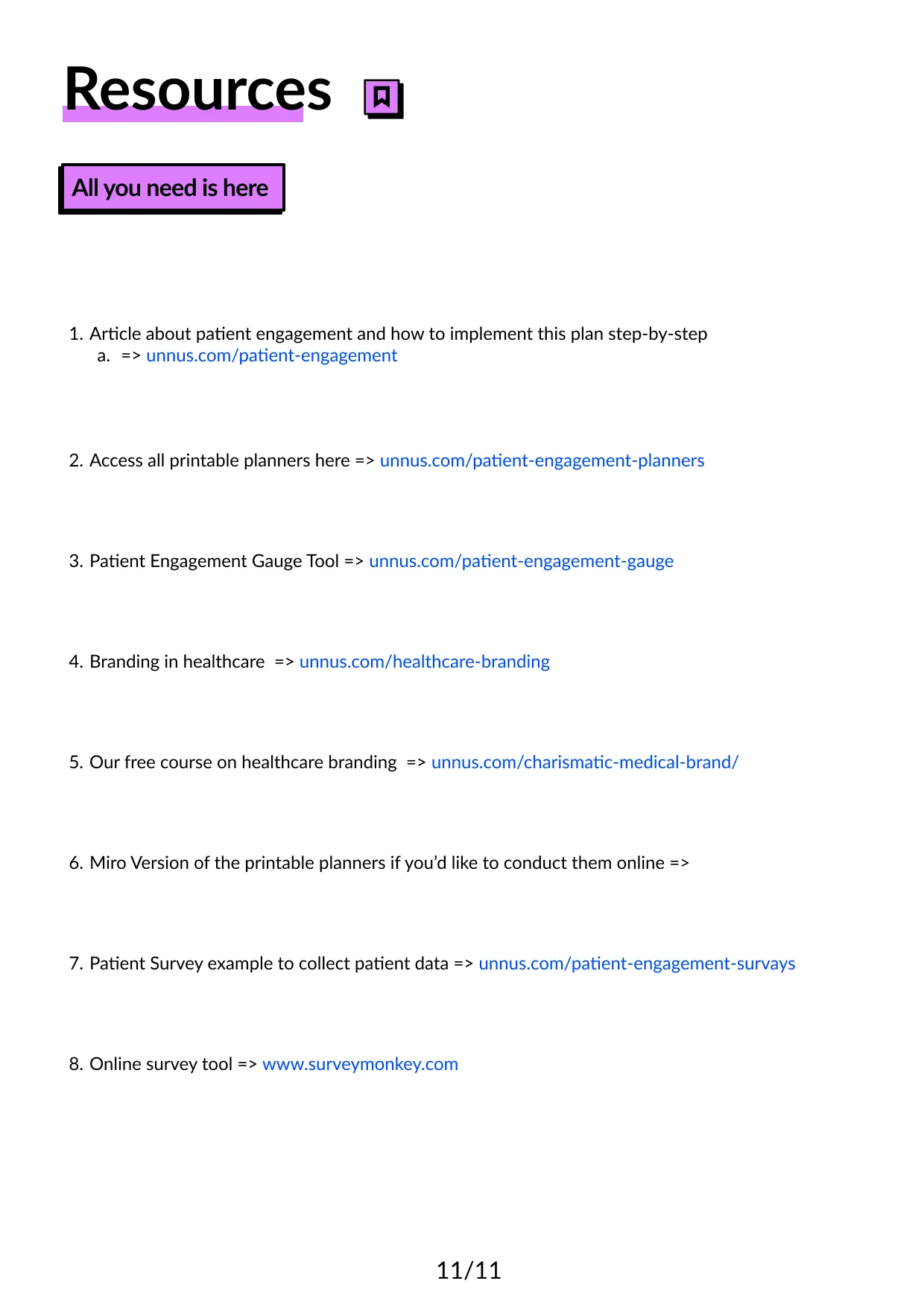
Added Delights: The Juiciest Patient Engagement Softwares
1) patient portals:
Patient portals allows patients to look at their health records like they’re snooping through a neighbor’s curtains. It makes the patients life easier when trying to book appointments or check on their health record.
2) Telemedicine Platforms:
The futuristic delight of having a virtual consultation. Your patients now can sometimes skip the waiting room and face-time their health back on track.
3) Clinic mangement softwares:
Imagine a multitasking assistant, but in digital form. It’s the conductor orchestrating the healthcare orchestra, handling scheduling, billing, and patient records with the finesse of a seasoned project manager.
4) Health Tracking Apps:
advocating health tracking apps for patients boosts patient involvement in the recovery.
These apps will be their cheerleaders in the pocket, constantly reminding them to drink water, hit those step goals, and even nagging gently about getting enough shut-eye. They make healthy living feel like a game.
Let’s wrap this with a bow, shall we?
These tools if implemented right, they’re like magic wands, transforming the ordinary into the extraordinary, from meh to memorable.
Remember, it’s not just about tools/data;
it’s about how these tools sculpt better outcomes, tighter bonds, and happier patients steering their health journey.
So, go ahead, dive in and watch as your clinic transforms from mundane to magnetic.
I hope this was helpful for you. If you need any help implementing this, feel free to reach me out.
I’d love to help.


